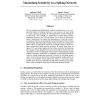396 search results - page 40 / 80 » How scientific models can explain |
MOZ
2004
Springer
14 years 29 days ago
2004
Springer
Abstract. Although Constraint Programming (CP) is considered a useful tool for tackling combinatorial problems, its lack of flexibility when dealing with uncertainties and prefere...
WSC
2008
13 years 10 months ago
2008
An increased need for collaborative research, together with continuing advances in communication technology and computer hardware, has facilitated the development of distributed s...
ARGMAS
2009
Springer
14 years 7 days ago
2009
Springer
Emotions play an important role in human decision making. This often has a beneficial effect, and so it is desirable to explore whether emotions can also play a role in agent dec...
FIRSTMONDAY
2007
13 years 7 months ago
2007
The debate on “openness” has tended to focus on standard setting, software copyrights, patent policy and collaborative innovation models – large issues that evoke heated deb...
NIPS
2004
13 years 9 months ago
2004
We use unsupervised probabilistic machine learning ideas to try to explain the kinds of learning observed in real neurons, the goal being to connect abstract principles of self-or...


